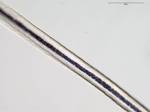Under construction May 2011
POLAR BEAR
Ursus maritimus
GUARD HAIR
Length: 30mm max (Brown 1942), 80-100mm (Adorjan and Kolenosky 1969), 90-170mm (ASM #2)
Diameter Range: 80-200 microns (Brown 1942) 125-175 microns (ASM #1 neck), 75-100 microns (ASM #1 belly), 125 microns (ASM#2).
Medullary Index: 0.37 ave (Brown 1942). 0.37 (ASM #1 neck)
Medulla: Continuous flattened globular cells rather uniform in size (Brown 1942). Continuous with intricate small cells, could be described as “highly vacuolated”(having many air spaces) similar to beaver. Has many small filamentous squiggly lines and some egg shaped voids that appear white (ASM #1 neck). The medulla is 65 microns in diameter on ASM #1 neck). In ASM #2 the medulla appears as fragmentary in the form of small slivers/dashes or long flattened disks, measured at 10 microns in diameter.
Color: Transparent cortex, not pigmented but may have fusi. Transparent (ASM #1 neck). Belly fur shows pink and blue pastel colors throughout the cortex (ASM #1 belly).
Scales: Scales torn paper-like and very jagged at the margins. The scales are consistent throughout the length of the fiber. (ASM samples) Need to see if this might help distinguish form other bears’ scales, which may be smooth edged near the base? Need to look at more polar bear scales to make sure they don’t get smooth edged near the base.
UNDERFUR
Length: 20-30mm (ASM #2)
Diameter Range: 44-120 microns (Brown 1942) 32.5 microns (ASM #1 neck)
Medullary Index: 0.36 ave (Brown 1942). 0.30 (ASM#1 neck).
Medulla: Brown calls the cells “thin plinths” (Brown 1942). Medulla appearance changes throughout the length of the fiber. It begins interrupted in long globular shapes, then changes to a more continuous uniserial ladder that in places looks like flat and thick coiled telephone cord from when telephones had those plastic coated cords that always bunched and tangled (ASM #1 neck).
Color: Pigment in the cortex but not the medulla. Translucent, no pigment visible
Scales: Stacked crowns or diamond petal shapes.
Macro Qualities: Animal is 6.5 -9.8 feet long (Forsyth 1999) 8- 10 feet long (ADF&G 2008) Coloration is white in winter, but can be yellowish or golden in summer and fall (Forsyth 1999) Guard hairs and underfur very shiny, almost glittery, under reflected light, rough and bristle-like (Adorjan and Kolenosky 1969)
Cultures:
Notes: ASM #1 is from I-B-476 on a taxidermy polar bear in off site storage, ASM #2 is from the education collection, a paw including the claws, ASM #3 is from a reference slide made by Alaska State Archaeologist Dave McMahan.
Troubleshooting: Arctic fox distinguished from polar bear: the latter’s shaft diameter is much larger (80-200 microns, as opposed to fox at only 37-132) and medulla is skinnier (polar bear at 0.37 and arctic fox at 0.61)
Range: Only the North Slope and the Seward Peninsula (Forsyth 1999) As far south as St Lawrence Island and possibly the Kuskokwim Delta (ADF&G 2008)
Names: Family Ursidae (the ursids) Used to be given its own genus, Thalarctos, but now is considered to be within the genus Ursus and thought to be evolved from brown bears and can breed with them (ADF&G 2008).







